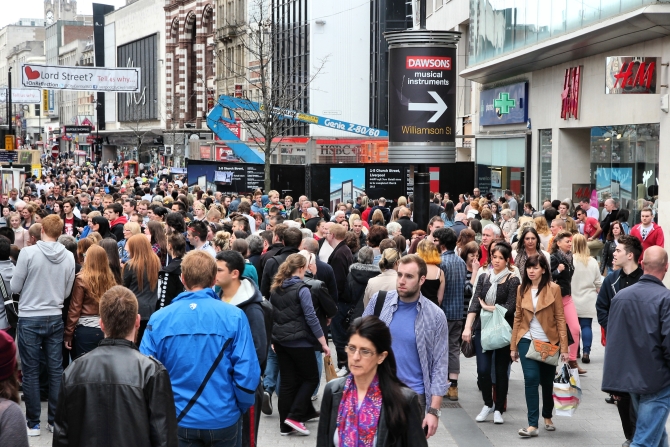Liverpool One — Merseyside’s prestige 170-store prestige retail complex — is playing a major part in filling dozens of empty shop units across the city, claims a new report.

According to the National Retail Barometer, published by property advisors Colliers International, Liverpool has shown the greatest improvement in halting Britain’s retail decline and attracting both shops and shoppers back to neglected high streets.
The report, which studied 15 major retail centres across the UK, highlighted Liverpool as returning one of the largest decreases in empty shops compared to the national average — with 20 retail units totalling more than 100,000 sq ft taken up in the six months between October last year and April, 2014.
In the half-year period the percentage of vacant shops fell to 11.8 per cent, down from 14.4 per cent. At the height of the recession In October, 2010, the figure stood at 16.3 per cent.
“Liverpool has become a key component of the North West’s retail trinity alongside the Trafford Centre and Manchester city centre,” explained David Fox, Colliers’ northern retail agency head. “After a very difficult opening at the height of the financial crisis in 2008, owner Grosvenor has firmly established Liverpool One in the hierarchy of UK shopping and leisure destinations.
“The tenant mix at Liverpool One has evolved to include the key attractions demanded by savvy shoppers such as a varied dining and fast food offer and a combination of high profile national multiples and emerging and regional operators,” he added.
The Retail Barometer’s findings were endorsed by Bill Addy, chief executive of the Liverpool BID Company, which represents 1,500 city centre businesses. “Liverpool’s appeal as a brilliant shopping destination is rippling right across the entire city centre with vacancy rates below 3 per cent on Bold Street,” he said.
“St Johns is now fully let and Clayton Square and Metquarter shopping centres and Cavern Walks are all undergoing major upgrades to make them even more attractive.”
Of the 15 locations sampled, Liverpool and Cardiff were the two top performers with Bournemouth, Northampton and Worcester also registering a marked decline in retail vacancy rates.
Overall the number of empty shops was the highest fall since 2006 with the sample centres collectively recording a fall in vacant space of more than 300,000 sq ft. Total vacancies across the 15 locations now stands at 1.8-million square feet.
There was little movement in the average length of time that shops sit empty, however. On average, 43 per cent currently remain vacant for more than a year.
Previous Post
London voted most Desirable City in the World to Work